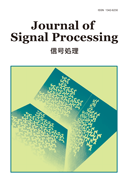All issues

Volume 21 (2017)
- Issue 6 Pages 233-
- Issue 5 Pages 211-
- Issue 4 Pages 121-
- Issue 3 Pages 89-
- Issue 2 Pages 47-
- Issue 1 Pages 1-
Volume 21, Issue 2
Journal of Signal Processing, Vol.21 (2017) No.2 (Editor-in-Chief: Keikichi Hirose, Editor:Yoshikazu Miyanaga, Honorary Editor-in-Chief: Takashi Yahagi)
Displaying 1-5 of 5 articles from this issue
- |<
- <
- 1
- >
- >|
-
Shunsuke Yamaki, Masahide Abe, Masayuki Kawamata2017 Volume 21 Issue 2 Pages 47-51
Published: February 20, 2017
Released on J-STAGE: March 25, 2017
JOURNAL FREE ACCESSThis paper gives a conjecture on the absence of limit cycles in second-order digital filters with minimum L2-sensitivity subject to L2-scaling constraints. We design second-order digital filters for various pole-zero configurations. For given second-order digital filters, we synthesize the minimum L2-sensitivity realizations and examine whether their coefficient matrices satisfy a sufficient condition for the absence of limit cycles. Experimental results show that the minimum L2-sensitivity realizations subject to L2-scaling constraints of second-order digital filters satisfy a sufficient condition for the absence of limit cycles for all given practical pole-zero configurations.View full abstractDownload PDF (3523K) -
Toshiki Mori, Takuma Yamagishi, Akinobu Murayama, Hiroshi Kubo2017 Volume 21 Issue 2 Pages 53-62
Published: February 20, 2017
Released on J-STAGE: March 25, 2017
JOURNAL FREE ACCESSThis paper proposes a demodulation scheme based on channel prediction for differential multiple-input multiple-output (MIMO) spatial multiplexing employing per-transmit antenna differential mapping (PADM). As PADM is one of the differential space-time trellis codings (DSTTCs), it requires per-survivor processing (PSP) based on the Viterbi algorithm (VA) for its demodulation. Therefore, PADM has excellent tracking performance on fast time-varying channels. However, aiming at higher frequency efficiency, PADM for a higher modulation index suffers from the following two disadvantages: (1) poor receiver sensitivity; (2) high computational complexity. In order to solve the items (1) and (2), this paper employs a spatial multiplexing structure and a state reduction algorithm for the VA, i.e., decision-feedback sequence estimation (DFSE), respectively. Finally, for a frequency efficiency of 4bps/Hz with two receive antennas, computer simulation results confirm that the proposed scheme has excellent bit error rate (BER) performance on fast time-varying channels in the case of the maximum Doppler frequency normalized by a symbol rate of 4%.View full abstractDownload PDF (1454K) -
Tomoko Kawase, Kenta Niwa, Yusuke Hioka, Kazunori Kobayashi2017 Volume 21 Issue 2 Pages 63-71
Published: February 20, 2017
Released on J-STAGE: March 25, 2017
JOURNAL FREE ACCESSNoise reduction has been extensively studied to prevent the accuracy of automatic speech recognition (ASR) being severely degraded due to various noise sources observed in practical use. The effect of noise reduction is usually dependent on the parameters used in the noise-reduction method, which need to be tuned for different types of noise to achieve the best accuracy. We propose a method for automatically switching noise-reduction parameters in such a way that ASR accuracy is maximized. The proposed method assigns the most suitable parameter set to each speech sentence by measuring and grouping the characteristics of noise observed in each sentence. Experiments using speech sentences contaminated by various types of noise showed that the proposed method can reduce the word error rate of ASR.View full abstractDownload PDF (1525K) -
Yuuki Tachioka, Tomohiro Narita2017 Volume 21 Issue 2 Pages 73-79
Published: February 20, 2017
Released on J-STAGE: March 25, 2017
JOURNAL FREE ACCESSSource localization techniques are important and effective for various applications. Without reverberation and noise, some conventional source localization techniques have achieved high accuracies. However, reverberation degrades their performance due to reflected sounds because they compare observed time differences of arrival (TDOAs) with theoretical TDOAs, which are derived from anechoic conditions and do not agree with actual ones under reverberant conditions. We propose a template-based method that compensates the discrepancy between theoretical TDOAs and actual TDOAs in order to reduce the influence of reflections. In this study, two types of experiments are performed to validate the effectiveness of the proposed method. The first one is a simple case that investigates the estimation accuracy in detail and the second one investigates a more practical case in a more complicated situation. For both cases, our proposed method can calibrate these errors effectively without increasing the computational time and improve the performance of conventional methods.View full abstractDownload PDF (697K) -
9. Symmetric Lossless Circuit Constituted with Image Connection of Asymmetric CircuitsNobuo Nagai, Takashi Yahagi2017 Volume 21 Issue 2 Pages 81-87
Published: February 20, 2017
Released on J-STAGE: March 25, 2017
JOURNAL FREE ACCESSAs described in Session 5, the vibration of a one-dimensional crystal can be explained using an LC ladder circuit. LC ladder circuits are asymmetric, lossless, and reciprocal. There are two methods of connecting two identical asymmetric circuits, image connection and iterative connection. The image connection of two identical asymmetric circuits forms a symmetric circuit. The functions of circuits depend on the connection method (which port of the circuit comes first). The passband of iterative circuits is wider than that of image-connected circuits, increasing the ranges and numbers of resonance and eigen-oscillation frequencies (energies). In circuits with image or iterative parameters, a stopband appears in the high-frequency (high-energy) region, suggesting the possibility that renormalization theory can be avoided by using circuit theory.View full abstractDownload PDF (501K)
- |<
- <
- 1
- >
- >|